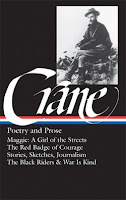From Stephen Crane: Prose & Poetry
Interesting Links
Resources for Teachers: “Crane, London, and Literary Naturalism” (National Endowment for the Humanities)
Obituary: “Stephen Crane Dead—Author of "The Red Badge of Courage" Expires in Germany” (The New York Times)
Previous Story of the Week selections by Stephen Crane
• “His New Mittens”
• “The Bride Comes to Yellow Sky”
Buy the book
 Stephen Crane: Prose & Poetry
Stephen Crane: Prose & Poetry
Includes The Red Badge of Courage, Maggie, George’s Mother, The Third Violet, “The Monster,” other stories, journalism, poetry, and more
1,379 pages
List price: $50.00
Web store price: $35.00
Resources for Teachers: “Crane, London, and Literary Naturalism” (National Endowment for the Humanities)
Obituary: “Stephen Crane Dead—Author of "The Red Badge of Courage" Expires in Germany” (The New York Times)
Previous Story of the Week selections by Stephen Crane
• “His New Mittens”
• “The Bride Comes to Yellow Sky”
Buy the book
 Stephen Crane: Prose & Poetry
Stephen Crane: Prose & PoetryIncludes The Red Badge of Courage, Maggie, George’s Mother, The Third Violet, “The Monster,” other stories, journalism, poetry, and more
1,379 pages
List price: $50.00
Web store price: $35.00
 |
| The Gang, circa 1894, oil on canvas by British-American painter John George Brown (1831–1913). Image courtesy of The Athenaeum. |
Crane was notorious for changing his mind about his books and their contents, and so his agent and his publisher ignored his latest brainstorm and proceeded with the original volume. They did, however, draw up a contract for a book of new Whilomville tales: including the four new stories he had completed, “at least twelve stories should be supplied, so as to bring the matter up to about 40,000 words.” The finished book was due in November. Then, in October, when Crane was nearly done with the required dozen, his common-law wife Cora wrote to his agent and proposed extending the series to a total of eighteen tales. It’s not clear who backtracked from this last-minute pitch, but in the end Crane submitted thirteen stories before the deadline the following month.
Literary scholar James Nagel has suggested that, given Crane’s desire to see them published together, all fifteen selections of the Whilomville series should be considered an early example of an American short-story cycle. Nagel points out that Jimmie Trescott, a character in many of the stories, functions “much in the manner of George Willard in Anderson’s Winesburg, Ohio or Nick Adams in Hemingway’s In Our Time.” He furthermore argues that these stories should not be categorized as children’s literature:
Part of Crane’s inventiveness in what became principally a series of tales about children is that he invested virtually all of them with mature ideas, essentially the same themes he employed in his adult fiction, issues of pride and humiliation, the illusion of stature and deflation, the desire for bravery and glory, the reality of cowardice and defeat.For each of the tales, Crane almost certainly drew on places, people, and events from his own childhood. Yet it would be a mistake to see Whilomville as a fictionalized, nostalgic version of Port Jervis, New York. While they were being serialized in Harper’s Magazine, Crane’s brother informed him that the stories were generating a certain amount of local gossip. “I suppose that Port Jervis entered my head while I was writing it,” Crane responded, “but I particularly don’t wish them to think so because people get very sensitive and I would not scold away freely if I thought the eye of your glorious public was upon me.” Crane scholar J. C. Levenson agrees that the stories are “not sufficiently accounted for in that way. . . . Crane had an interest in [Port Jervis’s] earlier history, but he did not feel called upon to record a real or fictitious past or any special flavor of local custom or dialect. Indeed, Whilomville is indefinite with respect to time as well as place.”
There is, perhaps, one notable exception. Two decades after Crane’s death, the reporter and occasional magician John Northern Hilliard wrote to biographer Thomas Beer and recollected his friendship with Crane: “He was exactly as he delineated Jimmy Trescott in the Whilomville Stories. He was Jimmy Trescott.”
Notes: The English system of fagging, mentioned midway through the story, refers to the tradition in British boarding schools in which younger students were personal servants to senior boys. Later in the story, Jimmie argues with a friend over the merits of two Uncle Tom’s Cabin companies. In the 1880s and ’90s, acting troupes crisscrossed the country, staging competing versions of the wildly popular stage adaptation of Uncle Tom’s Cabin. Advertisements boasted how each show offered the most extravagant spectacle, including the use of numerous live animals—particularly bloodhounds.
* * *
The child life of the neighborhood was sometimes moved in its deeps at the sight of wagon-loads of furniture arriving in front of some house which with closed blinds and barred doors had been for a time a mystery or even a fear. . . . If you don't see the full selection below, click here (PDF) or click here (Google Docs) to read it—free!This selection may be photocopied and distributed for classroom or educational use.